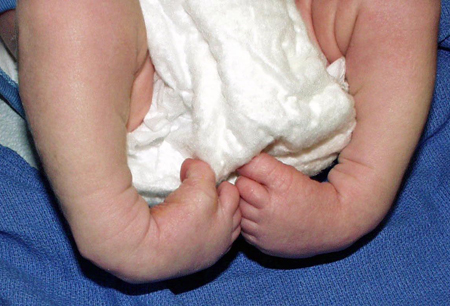Case history
Case history
A healthy newborn boy presents for assessment of a bilateral foot deformity. Antenatal ultrasound demonstrated findings consistent with bilateral clubfoot. There is no family history of clubfoot deformities. His examination is normal except for the deformities of his feet and possible hip subluxation. The foot examination demonstrates limited dorsiflexion of the ankle. The hind foot is in varus with the forefoot adducted. A cavus appearance of the mid foot is noted, with a deep crease in the instep. [Figure caption and citation for the preceding image starts]: Bilateral clubfeet in a newbornFrom the collection of Scott E. Van Valin [Citation ends].
Other presentations
Clubfoot deformity can present in various ways, from postural clubfoot (that can correct with simple stretching) to more severe deformities, which may be associated with various conditions. These include neuromuscular conditions such arthrogryposis, cerebral palsy, diastrophic dysplasia, polio, or spina bifida. Various syndromes have been associated with clubfoot deformities, such as amniotic band, Down's, Freeman-Sheldon, and Mobius.
Use of this content is subject to our disclaimer